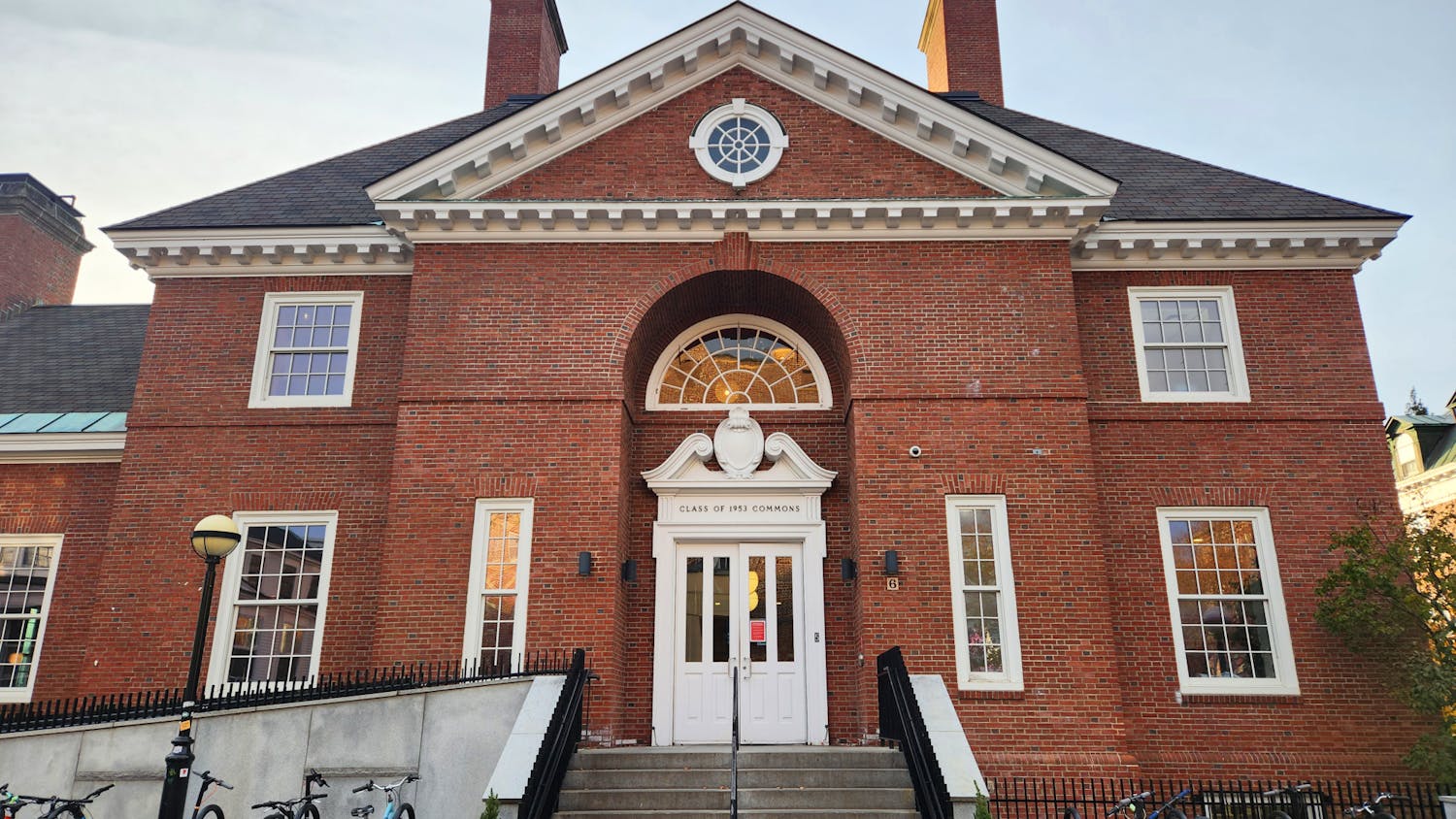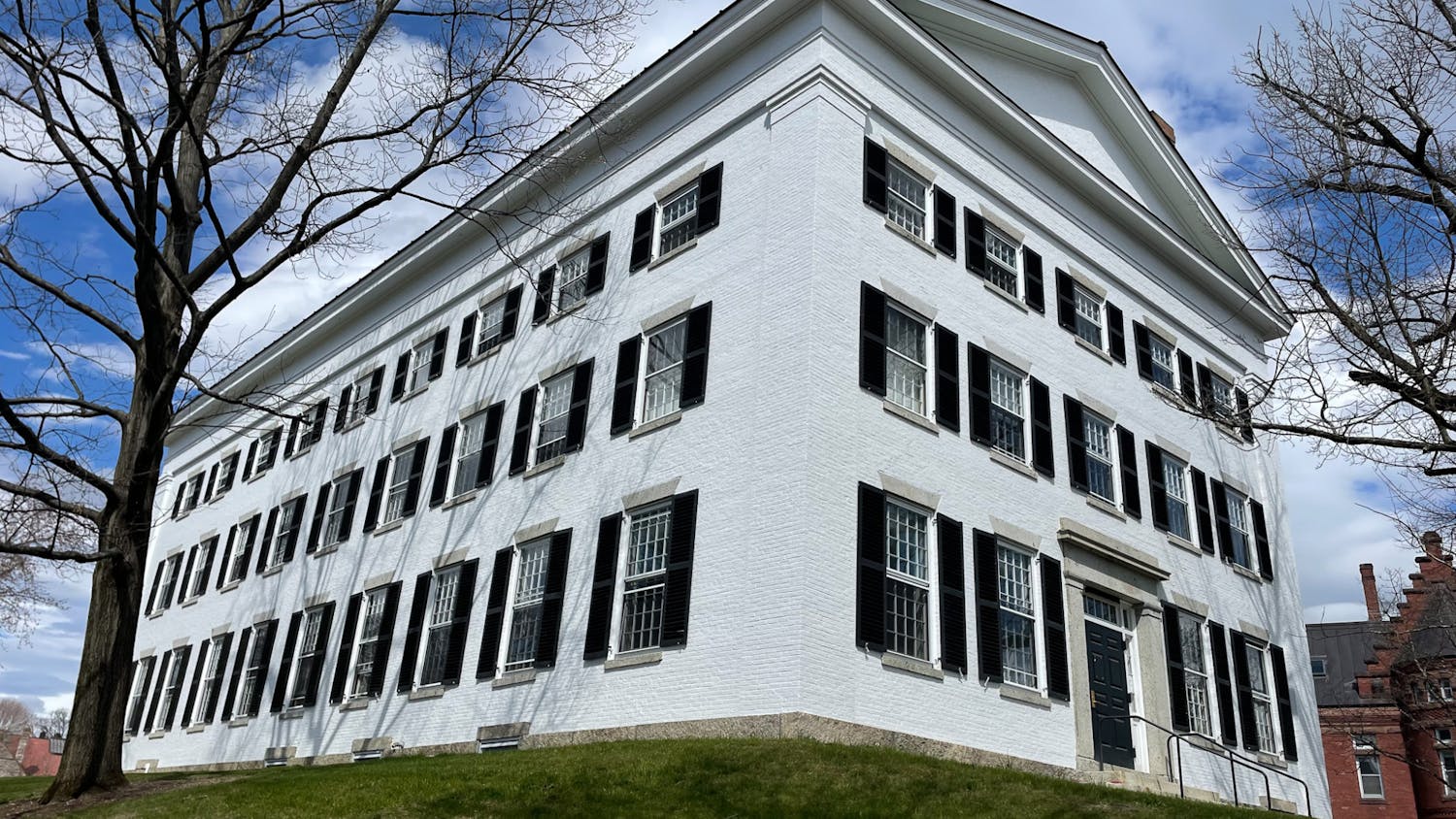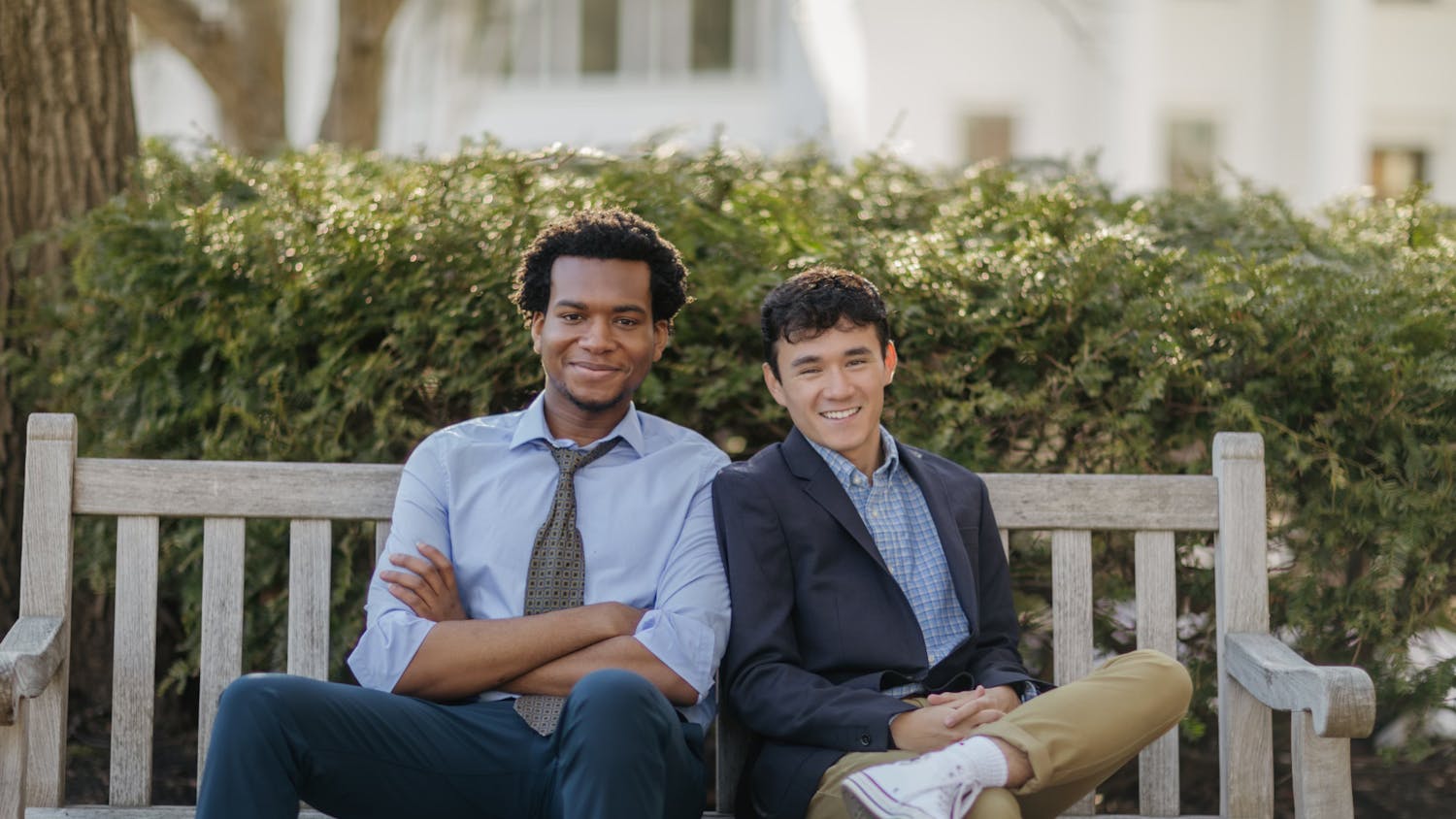The College has transformed dramatically over the years. From the early days of Eleazar Wheelock to the present, the student body has experienced much change as well, but one thing has remained constant.
Students have always needed food.
Today's student has the choice of many different eateries run by Dartmouth Dining Services. It was not so in the olden days.
In the earliest days of the College, students ate in the private residencies of professors, including the home of College founder Wheelock, according to information provided by Dining Services Director Tucker Rossiter.
There have also always been complaints about the food.
"I hope Providence designs to deliver us from the plague of unskillful, deceitful and unfaithful cooks, two of whom Mr. Woodward has lately ordered to the whipping post for stealing," Wheelock wrote in 1773.
In 1774, the poor quality of food at the College sparked complaints, which reached the ears of New Hampshire Governor John Wentworth, according to a history of dining prepared by DDS. One parent threatened a lawsuit against the College because of the food his son was receiving.
"The very name of putrefied, stinking provisions in a College alarms parents, who wish to secure health to their sons," Wentworth wrote.
Prior to 1776, boarding at the College was optional. Students who did board at the College received preference in room selection. Boarding with the College was required between 1776 and 1780, then the requirement was dropped.
In 1791, the College contracted the construction of a new dining commons, which was completed in 1793. The commons was not owned by the College but by two businessmen.
In 1807, the College bought the Commons building, and students ate there until 1815, when the College stopped providing food to students. Students ate at private homes or in eating clubs, some of which evolved into the fraternities of today.
Official College dining services resumed in the early 1900s, according to Assistant Director of Dining Services Jerry Gambell.
In 1901, the College Hall Commons, on the present site of Collis Common Ground, and a grill opened to serve the student body.
Meal service at the Commons was "family-style," which meant that the food was served as part of a complete meal, like the entree specials of today's Food Court and Home Plate. Unlike today's Westside Buffet, or Sunday Brunch at Home Plate, the meals were not all-you-can-eat.
Dining halls
In 1937, financial gifts from Henry Bates Thayer, Class of 1879 and president of AT&T, contributed to the construction of a new dining facility behind the commons and Robinson Hall.
Thayer Dining Hall originally consisted of the rooms which are now the lobby and Food Court, Rossiter said. There were three separate eating areas in Thayer: the Cafeteria, the Colonial Dining Room and the Rathskellar, a pub in the basement.
The Rathskellar became the Richard Hovey Grill during the 1940s. The Hovey Grill had a "cozy, congenial atmosphere that makes [students] comfortably warm inside," according to an advertisement in The Dartmouth at the time.
In 1957, the College added the space which currently holds Home Plate. In 1977, renovations added a loading dock at the rear of the building and extra dining space in what is now Westside Buffet.
Renovations over the period of 1983 to 1984 modified Thayer's interior, moving the dishroom to a more central location from its former site at the rear of the building.
In its early days, Thayer's primary function was to serve upperclass students. The College required freshmen to eat in the Commons.
Outside of the on-going modifications in Thayer, several other dining facilities were constructed around campus.
In 1962, when the Hopkins Center was opened, it had its own dining facility, the Courtyard Cafe. The building now known as the Collis Center had a small facility referred to today as Old Collis. Rossiter said Old Collis was very popular among the student body.
With the renovations to Collis in the early 1990s, Old Collis closed. When Collis reopened in early 1994, the present Collis Cafe opened its doors.
In the 1970s, complaints arose over the negative stereotypes of Native Americans in murals in the Hovey Grill, which depict the words to the Eleazar Wheelock song written by Richard Hovey, Class of 1885. These complaints led to a set of removable panels, which covering the images in 1983. With the opening of the Lone Pine Tavern in 1994, the Hovey Grill was closed.
On the periphery of campus are two lesser-known dining facilities that cater mostly to graduate students. Byrne Hall, which opened in 1994, serves the Amos Tuck School of Administration and Thayer Engineering School. Prior to the opening of Byrne, Stell Hall, which is currently a study lounge for graduate students, served the Tuck Drive graduate schools as a dining facility. Stell Hall opened in 1931.
"Upperclassmen, graduate students and faculty are invited to enjoy Stell's superior quality of food and service in congenial and quiet surroundings, away from the hustle and bustle of the campus," a 1937 advertisement in The Dartmouth read.
Cafe North, which shares a building with the Kellogg Auditorium, is near Dick's House, Gilman Hall and the Medical School. Cafe North opened in 1996, after Cynthia Ou was forced to move her Chinese restaurant downtown. Ou had been selling Chinese food in the cafeteria there since 1973.
The newest addition to DDS is the East Wheelock mini-snackbar, which opened last year.
Waiters in ties, the wars and Topside
Methods of payment for the College's food service have changed substantially over the years. Early in the days of the Dartmouth Dining Association, as the food service organization was formerly known, a paper punch-card system recorded students' meal purchases, Gambell said.
Today's all-day and late-night dining room service was unknown at the time.
"There used to be meal periods" for breakfast, lunch and dinner, Gambell said. Thayer's facilities consisted of five serving lines, four on the main floor and one on the second floor.
Students have almost always worked the serving lines, but their uniforms have changed over the years.
During the 1936-1937 year, complaints that "the Commons administration has been exceedingly lax in maintaining discipline among its student employees" led to reform, according to an article in The Dartmouth at the time.
"Waiters are now required to pass dishes to each freshman individually and are ordered to wear ties while working and not to wear ski boots or ski pants," the article stated. However, the "rule about ski boots ... which is arbitrary and needless, is widely violated," the article continued.
The world wars had a significant impact on food service at the College. During World War II, College students did not feel the heavy impact of the food rationing the rest of the nation experienced, according to Fletcher Clark '44.
"Food was what you always complain about, but it really wasn't that bad," Clark said.
However, the presence of thousands of Navy and Marine men in training in the College's V-12 program had an impact on College life.
An ad in the July 9, 1943 issue of The Dartmouth Log, which replaced The Dartmouth on campus during World War II, read: "'Chow' for 2,000 men three times a day and seven days a week is the war job of the Dartmouth Dining Association. Ours is a war schedule, too. In spite of increasingly difficult problems of food supply, we are doing our best to give you Marine and Navy trainees plenty of good healthy food."
Other places in the College area suffered the effects of war, too. A Hanover Inn ad that same month read: "We know that you get good food in the mess but for a change of scene on weekends perhaps you would enjoy the Dining Room and Terrace. We serve chicken and lobster all the time and occasionally we are lucky and have roast beef or steak on the menu ..."
After the war, life and food service returned to normal at the College. Over time, DDA added new innovations.
Between 1978 and 1980, limited late-night food service began on the second floor, with a small restaurant serving "hamburgers, hot dogs, sodas and stuff," Gambell said.
Through a "long, drawn-out process," DDA "kept adding stuff until it turned into a store," Gambell said. Nighttime operations were moved downstairs, and Topside convenience store was born.
According to Gambell, the magnetic-strip cards were introduced to record students' meal plans in 1981 or 1982.
Stripped
With the innovation of the magnetic cards, A La Carte arrived in the present location of Home Plate.
With the new cards and A La Carte option, the traditional meal plan "dwindled in popularity," causing a shuffling of rooms in Thayer, Rossiter said.
Full Fare, the all-you-can-eat predecessor to Westside Buffet, moved from the location of Food Court to its present location. The family-style service facility in Westside's current location, was bumped to its current location on the south side of the building.
The a la carte, late-night operation facility now known as Food Court -- the most popular facility -- moved to its current location.
Over time, DDA changed the traditional 14- or 21-meal per week "punch" plan so that it was only required for freshmen, and optional for upperclassmen, who could choose to charge meal costs on their magnetic card. The cards were only good at eateries in Thayer.
However, gender and class issues arose, Rossiter said, and student demand phased out the traditional meal plan option. Rossiter said men would generally order more food per "punch" than women, so women felt they were being treated unfairly. Also, freshmen thought it unfair that they had to have a meal plan while upperclassmen did not.
In addition, Rossiter said, the development of negative attitudes towards all-you-can-eat-style meals contributed to the decline in popularity.
The "punch" plan, with either 10- or 14-meal per week plans, was offered for the final time last year, and has since been fully replaced by varying levels of declining balances.
From mush to smoothies
While all these physical and commercial adjustments were being made, the content and price of the food itself changed as well.
A DDA menu given to the Class of 1914 listed various dining options at the Commons. The breakfast menu included a small sirloin steak for 10 cents. A "combination breakfast," which included California prunes, rolled oats with milk, baked sausage, baked potato, a muffin and a drink cost 15 cents.
The lunch menu included minced lamb on toast for 14 cents and corn fritters with maple syrup for eight cents. A combination lunch, including cream of celery soup, corned beef with cabbage, baked potato, bread with butter, steamed rice, apple pie and a drink cost 20 cents.
Another combination lunch option included fried mush with maple syrup instead of corned beef, and cost 15 cents.
For dinner, students could choose from a pork tenderloin saute for 16 cents or roast beef in pan gravy for 15 cents. A 25-cent combination dinner included beef broth, a choice of roast beef or pork, mashed potatoes, French bread with butter, Hubbard squash, rice pudding and a drink. Twenty cents could get the same meal with planked bluefish instead of beef or pork.
As time went on, prices went up. For the 1954-55 year, a dining plan for the semester between September and February allowed 21 meals a week for $220. For 15 meals a week, students paid $190.
Sara Starkweather '77 worked for DDA for a term while she was at the College. She said the food was very good.
"And there was certainly a lot of it," Starkweather said. "People always talked about the 'Thayer Layer,' which you usually put on your body your freshman year."
Starkweather said the Thayer of her day consisted of several lines of "the same thing" where students could get as much food as they wanted. There was also a salad bar.
Today's menu differs greatly from the original in constitution and price. Old favorites like meatloaf, veal, lamb and beef stew have lost popularity, Gambell said. The 1980s saw a substantial push by the student body for more vegetarian options, Rossiter said.
The increased cost of seafood has restricted its use in DDS facilities. Today, chicken, smoothies and deli wraps are very popular items. Pasta is also very popular.
"Put red sauce on it, and students will eat it," Rossiter said.
One casualty of the changing times was DDS's award-winning catering service, which was phased out two years ago. DDS still caters 75 percent of Commencement and Reunion Week activities, Rossiter said, but only because most regular DDS facilities are closed during that time.
A summer restaurant at the Dartmouth Outing Club cabin on Occom Pond suffered a similar fate. Rossiter worked at the restaurant when he was head of catering for DDS in the 1980s. The restaurant was closed after years of increased costs and declining patronage.
Napolitano and financial woes
Prior to the arrival of former Dining Services Director Pete Napolitano in March 1988, the College's various dining establishments were not operated by the same organization.
The facilities in Thayer, as well as the graduate schools' Stell Hall, all reported to DDA, while the facility in Collis reported to the dean of the College, and the Courtyard Cafe reported to the provost, Rossiter said.
Students could not use their meal plans at Collis or the Hopkins Center. After Napolitano's arrival, the Collis facility and Courtyard Cafe were integrated into DDA, to create Dartmouth Dining Services. Students could then use their meal plans at any of the College's facilities.
As DDS shifted from credit-based meal accounts to declining balances, the question arose about what to do with the funds which might remain in students' accounts at the end of a term.
For three years, DDS attempted "total refundability" of DBA funds at the end of terms. Any funds still in a student's account were credited towards the next term's food bill, or refunded.
"We all know what happened," Rossiter said. DDS's business decreased $1 million a year. The organization lost $400,000 in the 1996 fiscal year, according to College Treasurer Lyn Hutton.
Rossiter said the loss of funds could be traced to decreased sales matched with no change in services. Students were spending less money with DDS, but still expecting "we'd be open until 1 [a.m.] in Thayer," he said.
In addition, "programmatic" concerns, such as those at the Hopkins and Collis Centers, became a factor in DDS's policies. The DDS facilities in those areas were "important" to the buildings and their programs, Rossiter said, so they needed to be operated, even if they lost money.
During two years of declining business and fiscal loss, DDS made no substantial changes in its policies. Collis Cafe's menu became exclusively vegetarian in 1996, causing its sales to drop even more dramatically.
In Winter and Spring terms of 1997, an ad hoc committee of seven students and six administrators met to look for a solution to the problem. The committee proposed a mandatory, non-refundable $800 DBA for all students and cuts in DDS services, which it saw as "fair to everyone," Rossiter said.
The student body protested, and many students accused Napolitano of mismanaging DDS and ignoring student input.
Rossiter said many students felt they were "paying for the football team to eat," since athletes have a reputation for "consuming mass quantities."
A referendum in late April of last year ended with seven out of every 10 voters supporting reduced services rather than paying a mandatory, non-refundable $800.
DDS decided, among other changes, to restore Collis Cafe to a more inclusive menu and to close it on weekends, to close Food Court between 3 and 5 p.m. everyday and to return the Sunday Brunch to Home Plate. In addition, several non-student employees were laid off.
Instead of one flat DBA rate, DDS now offers four options. At the high end, students may pay $835 and receive an additional $65 of "free" DBA, for a total of $900 to spend. Next is the flat rate of $700. Below it is a rate of $475, which has an additional service fee of $50. Finally, a $300 plan with a $100 service fee is available for students who reside off-campus. All the plans are non-refundable.
Despite some initial growing pains, DDS's new policies seem to be working. "This has been a very good year," Rossiter said. He said that, with two months left to go in the academic year, all indications point to reduced losses for DDS.
"We're pretty close to break-even," he said, adding that DDS had hoped to break even after two years of the new operating procedures.



